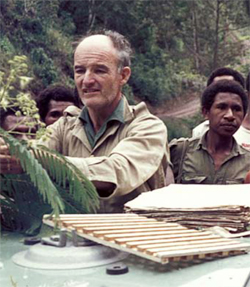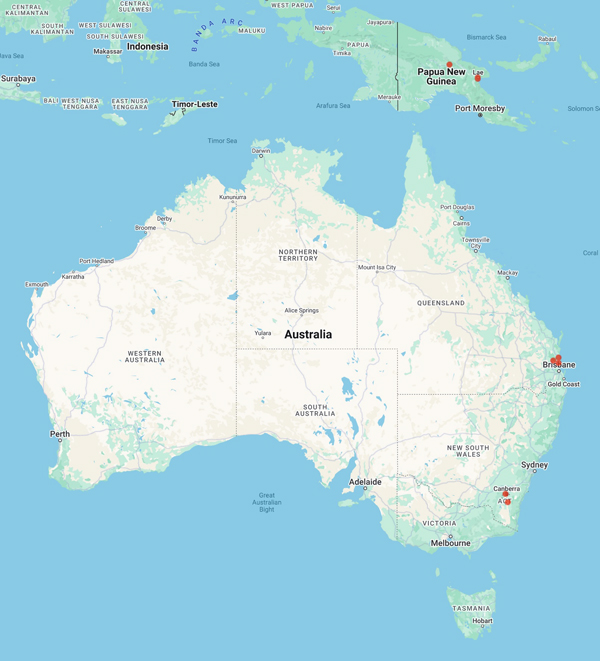
Council of Heads of Australasian Herbaria
Australian National Herbarium
Biographical Notes
 |
Council of Heads of Australasian Herbaria |
 Verdcourt, Bernard (1925 - 2011)
Verdcourt, Bernard (1925 - 2011) Born Luton, Bedfordshire, January 20 1925, died 25 October 2011
Known as "BV" to his colleagues, Verdcourt was responsible for almost one-third of the great Flora of Tropical East Africa, which deals with 12,500 species. Meanwhile, his extensive researches on East African molluscs culminated in A Revised List of the Non-marine Molluscs of East Africa in 2006, as well as in a mass of publications towards a full and thorough monograph of all the species from the area.
While botany was his profession, snails were — remarkably — merely a hobby; and many malacologists confessed that they never understood how Verdcourt found the time to study plants, given his published output on molluscs.
The grandson of a Belgian hatter, Bernard Verdcourt was born at Luton, Bedfordshire, on January 20 1925, and went to Luton Grammar School. His love of botany was fostered by the Luton amateur botanist John Dony, while the hymenopterist VH Chambers, who also lived locally, infused him with an interest in entomology.
In 1943 Verdcourt was called up, and trained as a radar operator at Reading University; after the end of the war he graduated with a degree in Radio Engineering, Physics and Chemistry. There followed three years with the Printing, Packaging and Allied Trades Research Association as a microscopist, mycologist and photographer before, in 1948, he joined the East African Agriculture and Forestry Research Organisation.
Following a year's training at the Royal Botanic Gardens, Kew, Verdcourt took ship to East Africa, and worked at Amani in Tanganyika (now Tanzania) under the eminent botanist PJ Greenway. He helped move the famous Amani Herbarium to its new building in Nairobi, where it became the East African Herbarium (it is now part of the National Museums of Kenya). The move involved driving quarter-ton trucks full of specimens round many muddy hairpin bends.
Fifteen years of naming many thousands of plant specimens for various researchers and the general public gave Verdcourt an unrivalled knowledge of the East African flora and its literature. Time for research and writing was very limited, but he gained an external PhD from Reading University in 1955, and collected more than 4,000 plant specimens with many duplicates, many of which are cited in the botanical literature. He also collected East African land snails and slugs, now mostly in the National Museums of Kenya and the British Natural History Museum.
After serving from 1958 to 1964 as Botanist-in-Charge of the East African Herbarium, in 1964 he returned to England and worked at the Kew Herbarium, first as Principal Research Fellow, and later as a Principal Scientific Officer, until his retirement in 1987.
In retirement, Verdcourt continued his work on the Flora of Tropical East Africa, the Flora Zambesiaca and the Revised Flora of Ceylon. In his eighties he was still working at Kew four days a week, publishing prolifically. He remained much sought after for advice and plant identifications, and became known for the civilised coffee breaks he hosted in a hidden corner of the Kew herbarium for colleagues and visiting scientists (the beans were freshly ground in an ancient Peugeot coffee mill).
Apart from a period in the mid-1970s, during which he worked on New Guinea legumes, and some contributions to the Flora of Sri Lanka, Verdcourt devoted himself almost entirely to East African botany.
In 1978 Verdcourt was climbing a small rock hill in Tsavo, collecting plants and slugs, and was looking into the crown of an Acacia when he trod on something soft and yielding. Looking down, he found that he had trodden on a lion - a young male. Verdcourt retreated, yelling loudly at the lion, who got up lazily and started following. Once he had managed to get about 20ft between them, Verdcourt turned tail and fled down the rocks. He later discovered that this was the area in which the infamous "man-eaters of Tsavo", at the turn of the 19th and 20th centuries, had killed and eaten some 140 railway workers.
Verdcourt had an intense dislike of all sports and games ; but he did take part in motorsport in East Africa, including the very tough East African Safari Rally (then called the Coronation Safari); he even finished on one occasion — in 1958, with Alan Rogerson in his Peugeot 403. He had a particular interest in historic cars of the Peugeot marque, and was a keen member of the Club Peugeot UK.
A prolific author, he published more than 1,200 papers and books on entomology, malacology, botany and the Peugeot marque, but felt that he had scarcely done anything of real scientific worth — "Just a mass of descriptive material, useful, requiring judgment and knowledge but scarcely any intelligence," as he once said.
Others felt differently, and he was honoured with the Kew Medal in 1986; he was president of the Conchological Society in 1969-70; honoured by the Linnean Society of London with their Gold Medal in 2000; and he was named a Corresponding Member of the Association of American Plant Taxonomists in 2008.
"Bernard Verdcourt certain visited Oz at least once, and worked on some sort of taxonomy because I remember him telling us all he was going to describe something new either from Australia or New Guinea (but I can't remember what).
He certainly also went into the field while here, and apart from a small amount around ACT, his major day out was collecting with Lyn Craven in the Tinderries on Feb. 5th 1978 (we have duplicates in CANB)."
Laurie Adams 2011
Source: Extracted from: http://www.telegraph.co.uk/news/obituaries/science-obituaries/8860991/Bernard-Verdcourt.html 31.10.2011
pers.com. Laurie Adams, CANB, 31.10.2011
Portrait Photo:PNG ex ASBS Newsletter No.149, 2011
Data from 30 specimens
